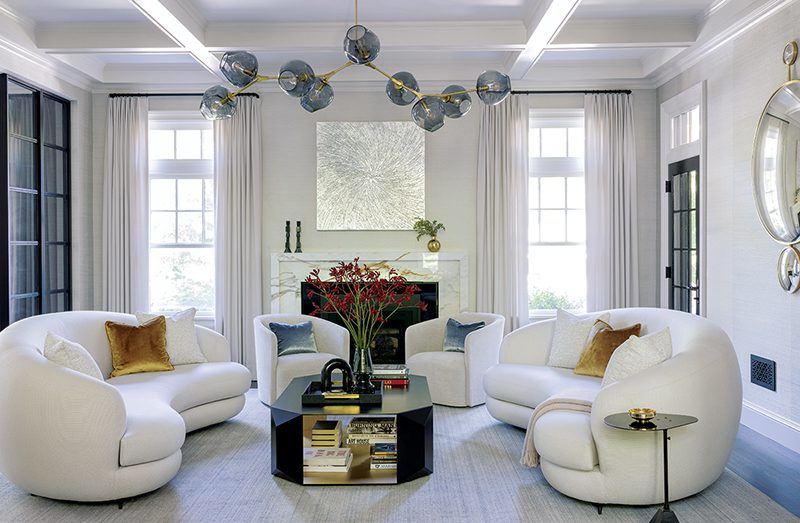Galleries

Three boys share this reimagined second-floor bedroom. When the trio demanded bunk beds to match those in their sisters’ room, interior designer Patti Watson opted for a stowable rope ladder to save space in the tight confines. The room utilizes an antique brass bed and a glass-sided cabinet from the owners’ collection.

Working with the sloped topography, the team carved out land at the back of the house in order to create a walk-out garden level while still meeting the town’s twenty-four-foot height restriction for gabled roofs. “The house is really nestled into the land, with the back side walking out to a patio and the two-and-a-half stories above it exposed to the views,” Stephens says.

Landscape architect Dan Gordon and landscape designer Peter Stephens played off remnants of existing stone walls when organizing the site and developing what Gordon describes as a casual agrarian style. “We’re tying into the character of the landscape instead of imposing something different on it,” he explains.

“The stair towers let light into the ends of the house, so no matter which direction you walk, it’s always toward the light,” architect Patrick Ahearn says. The bays are clad in charcoal-colored weatherproof boards meant to resemble metal, and the exaggerated smokestacks feature classic chimney pots.

Vertical color is encouraged by a square-pattern lattice on the side of the guest cottage/garage and an arbor for roses above the doors.

Nestled into the lush natural vegetation of its coastal location, “the home evokes time and tradition within its setting,” says interior designer Terri Ricci. Cedar shingles weathered silver-gray by sun and salt air reinforce the low-key vibe of a beach house, which sits at the end of a stepping-stone path.

The owners took advantage of the renovation to make the house as sustainable as possible, opting for solar panels, Tesla backup batteries, and electric heat pumps, among other things. “We were able to achieve a much more airtight building than a 1920s brick colonial would normally allow for,” says Laura Burnes of Adams + Beasley Associates.

Sherwin-Williams’s moody Still Water paint in semigloss gives the living room a warm, enveloping feel. Designer Erin Gates mixed traditional pieces like the homeowners’ own antique chest with more modern details such as the Visual Comfort & Co. chandelier with its milky handblown glass disks. She added shots of chartreuse, in the Kelly Wearstler drapery fabric and a toss pillow, to play off the artwork.

The shop’s fabulous finds include a sofa upholstered in fabric by Alan Campbell for Quadrille, a vintage pencil-reed cocktail table featuring a palm leaf design, and vintage carpet beaters that flank contemporary photography. Harper customized the barstool with the location of her South Carolina wedding, a palm tree, and a burgee flag.

In the wife’s bath, the cast-iron Penhaglion tub showcases a polished stainless-steel finish. The vintage pendant hanging above was purchased in New Orleans. “That’s an actual crown on top of the beadwork,” says Pippo, who covered the ceiling in a Holly Hunt paper that sports a gold and silver sheen.

The couple’s portrait collection watches over many rooms in the house, including the Christopher Peacock-designed kitchen. The wife, says interior designer Antonio Pippo, was adamant the kitchen island not include seating. “She didn’t want people gathering around the island,” says Pippo. “She wanted them to be elsewhere, having fun.”
![NEH-Logo_Black[1] NEH-Logo_Black[1]](https://www.nehomemag.com/wp-content/uploads/2022/08/NEH-Logo_Black1-300x162.jpg)





























































































































































































You must be logged in to post a comment.